
In thinking about water storage for you and your family, I’ve been fascinated by how Israel solved their water problem. In his book, Let There Be Water: Israel’s Solution for a Water-Starved World, Seth M. Siegel tells how Israel, which is 60% desert became a water superpower.
One point that stood out to me was getting residents to “buy in” to the importance of cherishing a most valuable resource. Real market pricing took care of that in a way that subsidized water never could. If something like water was free or cheap, then why not use as much of it as you could? Whereas, when charged a market price on par with costs, consumers became much more conscious about their water usage.
Another point I liked was Israel’s adoption of easy to implement drip irrigation. Unlike the flood irrigation predominant on farms in the U.S., “Irrigating a plant drop by drop limits evaporation and delivers the water that the plant needs directly at its roots. The water savings are significant—only four percent of the water is lost to evaporation or unnecessary absorption into the soil,” explains Siegel.
Next, there’s the work Israel has done on desalination, which provides “the equivalent of ninety-four percent of Israel’s household water,” Siegel points out.
A lot of Israel’s success, like anything, came from need or survival. Need motivates. I want you to think about your family’s water needs. In a disaster, you’re dealing with uncomfortable scenarios. Taking a minute to think about water usage and where it comes from, like Israel had to do, will help you discover ways to improve your water situation when you need it most.




